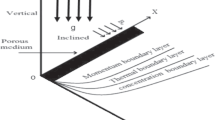Abstract
In recent years, the development of two-phase flow cooling systems in micro-electronic as well as surface coating/patterning technologies, often based on thin films and liquid filled micro-enclosures, has renewed the interest in the classical problem of the cavity flow driven by a shear stress imposed at the gas-liquid boundary. In this paper, we study, numerically, the influence of the cavity geometry and boundaries on the three dimensional velocity field driven by a shear flow of inert gas. This study has been performed in the frame of the ESA sponsored Space Program on heat and mass transfer CIMEX-1 and it has to be considered as a contribution in the preparation of the Space experiment. The reference values for the flow parameters as well as the geometrical features encountered in the present paper target the main features of the CIMEX-1 experiment, although the main conclusions can be considered of general validity.
Similar content being viewed by others
References
Erturk, E.: Discussions on driven cavity flow. Int. J. Numer. Methods Fluids 60, 275–294 (2009)
Faure, T.M., Adrianos, P., Lusseyran, F., Pastur, L.: Visualizations of the flow inside an open cavity at medium range Reynolds numbers. Exp. Fluids 42, 169–184 (2007)
Goncharova, O., Kabov, O.: Gravitational-thermocapillary convection of fluid in the horizontal layer in wake gas flow. Dokl. Phys. 54(5), 242–247 (2009a). Summary: an exact solution of a stationary problem of convection in a horizontal layer with free boundary being under action of a co-current gas flow is constructed
Goncharova, O.N., Kabov, O.A.: Numerical modeling of the tangential stress effects on convective fluid flows in an open cavity. Microgravity Sci. Technol. 21(1), 119–128 (2009b). Summary: the effects of the spatially variable tangential stresses on the convective fluid flows in an open cavity have been investigated numerically
Grace, S.M., Gary Dewar, W., Wroblewski, D.E.: Experimental investigation of the flow characteristics within a shallow wall cavity for both laminar and turbulent upstream boundary layers. Exp. Fluids 36, 791–804 (2004)
Haut, B., Colinet, P.: Surface-tension-driven instability of a liquid layer evaporating into an inert gas. J. Colloid Interface Sci. 285, 296–305 (2005)
Iorio, C.S.: Experimental and numerical study of the coupling between evaporation and thermocapillarity—preparation of the Cimex-1 Experiment. PhD dissertation, Université Libre de Bruxelles. http://theses.ulb.ac.be/ETD-db/collection/available/ULBetd-09132006-144719/ (2006)
Iorio, C.S., Kabov, O.A., Legros, J-C.: Thermal patterns in evaporating liquid. Microgravity Sci. technol. XIX-3/4, 27–29 (2007)
Iorio, C.S., Goncharova, O., Kabov, O.: Study of evaporative convection in an open cavity under shear stress flow. Microgravity Sci. Technol. 21(1), 313–320 (2009)
South, M.J., Hooper, A.P.: Linear growth in two-fluid plane Poiseuille flow. J. Fluid Mech. 381, 121–139 (1999)
Author information
Authors and Affiliations
Corresponding author
Rights and permissions
About this article
Cite this article
Iorio, C.S., Goncharova, O. & Kabov, O. Influence of Boundaries on Shear-driven Flow of Liquids in Open Cavities. Microgravity Sci. Technol. 23, 373–379 (2011). https://doi.org/10.1007/s12217-011-9257-6
Received:
Accepted:
Published:
Issue Date:
DOI: https://doi.org/10.1007/s12217-011-9257-6




